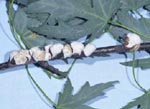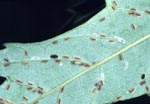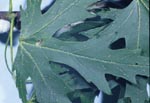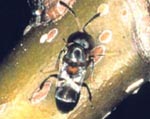Cottony Maple Scale
Pulvinaria innumerabilis
Description
The overwintering form of the cottony maple
scale is a small, brown, flattened 1/8 inch long scale attached to the
bark of twigs and small branches. During the summer, the scale enlarges
by secreting wax resulting in a body several times greater than the
overwintering form. The body of the scale is white and resembles a
kernel of popcorn. The immature scale is flat, oval shaped, and light
yellow to green. The eggs are usually brown.

Figure 1. Cottony Maple Scale
Life History
The cottony maple scale is common on maple,
boxelder, hackberry, dogwood, beech, apple, oak, linden, honeylocust,
and elm. The scale overwinters as an immature female on the twigs of the
host. By late spring the insect has developed into a mature female and
begins laying as many as 1,000 eggs. The eggs hatch into crawlers in
late June and July and move from the twigs to the leaves where they feed
along the midrib or the veins. Late in the summer, mature winged males
mate with immature females. The males die within a few days after mating
as they are unable to feed. Before leaf drop in the fall, the immature
females move back to the twigs to overwinter. There is one generation
per year.

Figure 2. Cottony Maple Scale on
Silver Maple Leaf
Damage
Damage to the host tree is caused in several ways.
If scale populations are heavy, dieback of branches and twigs may
result. In severe cases the tree may die. Feeding by the scales may
result in heavy concentrations of honeydew. This honeydew is readily
colonized by sooty mold fungi which will result in a blackened
appearance to leaves, twigs, and branches. In some cases, premature leaf
drop may also occur due to scale feeding. The honeydew also becomes a
nuisance due to deposits on automobiles and lawn furniture located under
infested trees.

Figure 3. Cottony Maple Scale Crawlers
Nonchemical Control
There are a number of natural enemies
of the cottony maple scale including a number of wasp and fly parasites.
Natural predators such as various species of lady beetles feed on the
immature scales situated on the leaves. Outbreaks generally buildup over
a period of years and then disappear due to natural enemies and
climatic factors. Well established and vigorously growing trees are
usually able overcome the infestation.

Figure 4. Wasp Parasite
of Cottony Maple Scale
Chemical Control
If scales are heavy on stressed or
unestablished trees, a crawler spray may be applied in July in order to
prevent dieback and decline. A dormant oil spray applied to the trunk
and branches of the tree may also be used to reduce overwintering female
populations and eliminate the risk of killing off beneficial insects
such as lady beetles and parasites.